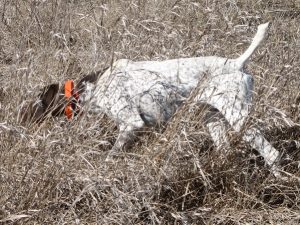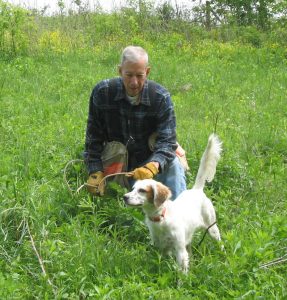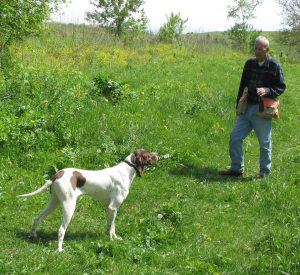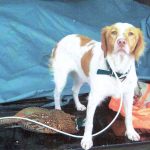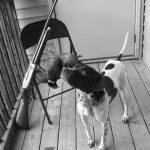Creeping on Point
Pointing Dog Pointers
by Bob and Jody Iler
Creeping on point is a common problem that can sometimes occur in the development and training of pointing dog pups and young started dogs. Your young dog may have started out pointing birds with intensity. But as you continued in your training program with her, you noticed that she would point, and then start creeping slowly toward the bird.
What causes creeping? And what can you do to resolve the issue?
Assuming that your dog comes from good bloodlines with dogs that have lots of pointing instinct, you can usually make a safe bet that it’s something you’ve done in your development program that is causing the problem.
The most obvious cause of creeping on point is letting the pup catch birds. Once a pup learns that if he goes off point and “creeps” slowly toward the bird, he can catch it, we have a problem—for the smart pup will remember this and begin to creep each time. Even though we encourage very young pups to catch birds during the bird introduction phase to whet their excitement, once the pup knows what he’s out in the field for and starts pointing when he scents a bird, we no longer want him to catch them!
Creeping is not to be confused with “busting birds,” although a pup that begins creeping can sometimes develop the problem of busting birds as well. A young dog that busts birds will often not point at all, charging right in to flush the bird when he first gets scent. These dogs may lack pointing instinct, or in many cases, they may have caught so many birds that they simply no longer point.
For example, one of our clients brought a nice young Shorthair to the kennel because the dog had quit pointing and he hoped we could correct the problem. After we asked what the owner had done in the way of training before we got the dog, he explained that initially the pup had shown lots of point. Then he bought some Japanese quail to work the pup on. These quail were not good flyers and his pup could easily catch them. As he continued to use the quail, he inadvertently turned his pup into a flushing dog! So…
Rule # 1: Once your birdy pup points and then begins to creep, he’s letting you know that it’s imperative that he not catch birds anymore!
Using traps in training can accentuate this problem. Once a pup learns that a bird in a trap cannot get away, he may start to creep toward the bird in the trap, in anticipation of jumping in on it. The use of traps has its place in training, but pups worked on birds in traps should always have a checkcord on so that they can be restrained once on point. Also, pups can become “trap-wise” and will learn to scent the trap. This, in turn, will soften a pup’s point, paving the way for creeping. Don’t overuse bird traps!
Using planted birds that have been dizzied or “dead-planted” so well that the dog can jump in and catch them is another no-no. You want your planted bird to be disoriented for the few minutes that it will take you to get your pup to the area—but then you want that bird to be ready to fly. For novice (and even experienced) trainers, this can be an art!
Using spooky, released birds that fly well and will flush if the dog gets too close are the best cure for creeping.
Rule # 2: If your dog is creeping, it’s time to make sure that you put a good “whoa” into her!
We introduce young pups to the whoa command on a basic “puppy” level when they are very young. But as they advance in training and begin field work, we want that whoa to become more pronounced.
Go back to your yard work program and work with your dog until you can put her on a whoa command and walk in a complete circle around her without the young dog moving. Always return to your dog on the whoa command; never call her to you from the whoa position.
This will take time if you didn’t lay your foundation initially. Don’t move too far away so that you can’t correct your dog if she moves. Stay close and gradually increase your distance as she learns what you want.
Then, in the field, with your checkcord on the dog, you will gently command whoa once your dog goes on point. Keep your checkcord taut and restrain your dog as a helper flushes the bird for you. Enough repetitions of this will begin to instill a good whoa in your dog as the bird flushes. At this point in your training, you are working on stopping the creeping, not steadying to wing or shot.
Rule # 3: Be aware that game preserve birds can sometimes exacerbate the creeping problem.
Though we consider game preserves to be great places to train and hunt with our dogs, young dogs worked on pen-raised game preserve birds can sometimes catch the ones that hunker down and don’t fly well, or birds that simply run and don’t fly. In this scenario, you might try using different types of birds to see which ones are the spookiest to use. We often use chukars because they will sit tight but generally flush and fly well.
Rule # 4: The very best “training birds” for your dog that creeps will be wild birds.
Once he finds that he can’t catch them, he will learn caution and will tighten up on point.
With young eager pups that often creep, it sometimes helps to work them without birds for awhile, say, a week or two. Run them in the field as usual, but not on birds. Then, just reintroduce one bird during that second week. Sometimes the excitement of finding a bird again will be enough to bring out that intensity on point.
As dogs mature, they will often learn to “relocate” a bird on their own. This may seem like creeping, but in actuality, the bird is running rather than sitting tight. The dog will initially go on point, and then may move a short distance and point again, and so on. If you know your dog well, you’ll become accustomed to his relocating in situations like this. In advanced field dog competition, you would need to ask the judge for permission to let your dog relocate, but many hunters prefer that their dogs relocate on running birds on their own.
Hopefully these tips will help you address the common issue of creeping on point!
Pointing Dog Pointers features monthly training tips by Bob and Jody Iler, who own Green Valley Kennels in Dubuque, Iowa. Bob and Jody have trained pointing dogs for over 35 years and have written many articles for The Pointing Dog Journal.



